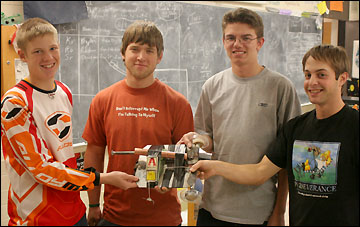Physics students fare well at competition
The four-man team of junior Lee Buerman, senior Dugan Flanders, junior Jake Mackedanz, and senior Brad Torborg led the way by placing second in an impromptu competition for tower building with popsicle sticks and fifth with their projectile launcher.
 For the impromptu competition, teams had to build a tower using seven popsicle sticks and two meters of string. The purpose was to design a tower that could hold the most weight respective to its own weight, a ratio of the weight held divided by the weight of the structure itself.
For the impromptu competition, teams had to build a tower using seven popsicle sticks and two meters of string. The purpose was to design a tower that could hold the most weight respective to its own weight, a ratio of the weight held divided by the weight of the structure itself.
Junior Jake Mackedanz, senior Brad Torborg, junio Lee Buermann, and senior Dugan Flanders placed second in the tower building competition and fifth with their projectile launcher at St. John's University/College of St. Benedict's engineering day on Friday, Oct. 27. Eleven PAHS physics students participated that day.
Buermann, Flanders, Mackedanz, and Torborg designed a teepee-like structure that used nearly all their sticks and most of their string. Their structure was roughly 3.5 inches wide and 4.0 inches tall.
It held 647 kiloPascals of pressure - as measured by a pneumatic press - which was the most of the 19 entries in the competition. (Second was 583 kiloPascals by the third-place team.) "Ours was by far the strongest," said Flanders.
But the ratio to determine the winner divided the pressure held (before the towers were crushed) by the weight of the structures. The PAHS foursome's teepee weighed 9.4 grams, yielding a ratio of 68.83 kiloPascals per gram. A team from St. John's Prep designed a structure that held 342 kiloPascals and weighed only 4.9 grams, for a winning ratio of 69.80.
The team decided on a teepee because it was the "only way to keep ...(the sticks) all together with the amount of string we had," said Torborg. That their structure turned out to be so strong was a lucky guess, added Mackedanz.
Their classmates said this team enjoyed an unfair advantage of using a regular pair of scissors to bore holes in their popsicle sticks, but team members noted that they did not know they weren't supposed to use another scissors and that they finished with plenty of time.
The PAHS team of junior Dakota Block, senior Cary Schlick, junior Edwin Twedt-Coulter, and junior Chris Van Eps finished 14th in the tower-building contest, also building a teepee-like structure. The third PAHS team did not finish building their structure for this contest.
Buermann, Flanders, Mackedanz, and Torborg also placed fifth out of 20 teams in the projectile launcher. Teams were charged with building a machine that could roll two feet and then launch a pencil at a target six feet away.
The PAHS foursome actually built two projectile launchers. The one they used in the competition, mainly designed by Buermann, used a rubber band for power (with Buermann stretching the band to have it pull the wheeled launcher two feet forward). A string tied to an axle pulled a pin that released the pencil, powered by another rubber band. Their best shot at competition was 16 centimeters from the target.
Another launcher, primarily designed by Mackedanz and Torborg (and pictured above), used a mouse trap to power it. This trap sprung another mouse trap that pulled the pin on a compressed spring and launched the pencil. It developed problems with the glue holding the second mouse trap the day before the competition.
Buermann said his projectile launcher had done better in practice. One key variable was that he had to pull the launcher back the right amount to stretch the rubber band and power the vehicle.
The winning team launched its projectile a few centimeters from the target.
Block, Schlick, and Van Eps placed 14th out of 22 teams in the musical brakes competition. In this event, teams built a vehicle (with CDs for wheels) that were rolled down a ramp and had to stop at a certain mark. Their vehicle used a string tied to the axle as a braking mechanism. The winning team actually backed up their vehicle and finished just a few millimeters from the mark.
Senior Aaron Burris, junior Colby Peterson, and junior Cory Spanier finished seventh out of eight teams in the electromagnet speaker-making competition. They used two magnets to power a voice coil which was amplified by a cardboard Bulldog megaphone. It produced a sound of 60 decibels at the competition. (Actually, the sound was louder, but they had to subtract teacher Jay Thompson's yelling.)
The winning team - who built an actual wooden speaker box - produced a sound of 92 decibels.
Contact the author at editor@paynesvillepress.com • Return to News Menu
Home | Marketplace | Community